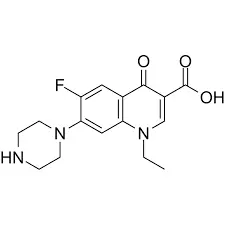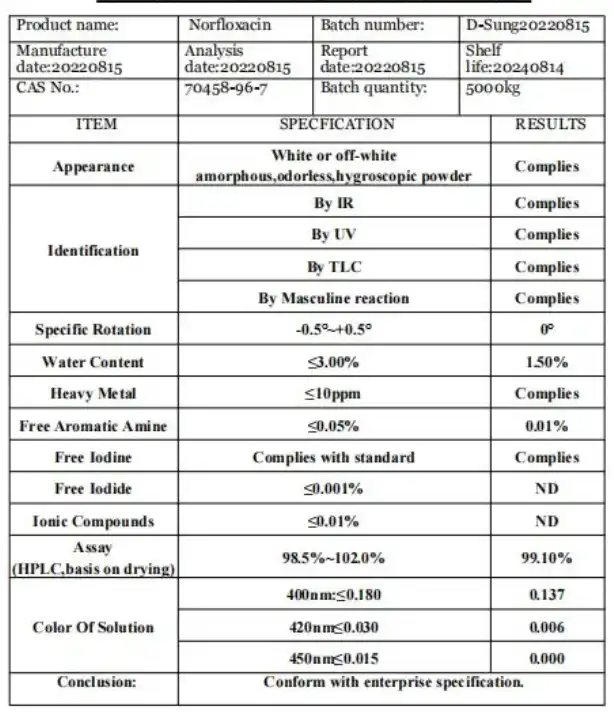Norfloxacin powder is a powerful synthetic antibiotic belonging to the fluoroquinolone class of drugs. This drug's ability to combat a wide variety of bacterial illnesses is relied upon by both animals and humans. A key enzyme in DNA replication, norfloxacin powder works by blocking this enzyme in bacteria. This inhibition leads to the death or inhibition of sensitive bacterial growth. Because of its broad spectrum antimicrobial activity, it is a versatile treatment option for a wide variety of diseases. Infections of this kind can cause issues with the lungs, the digestive system, and the urinary tract. Powdered norfloxacin has various medical applications since it is more accurate to dose and easier to combine with other medications.

How does Norfloxacin powder combat urinary tract infections?
Mechanism of action in urinary tract infections
Because of its special action mechanism, norfloxacin powder is quite effective in treating UTIs. When administered, the powder form of norfloxacin is rapidly absorbed and concentrated in the urinary system, reaching high levels in the urine. Because of its high concentration, the antibiotic is able to kill the infection-causing bacteria at their source. Norfloxacin powder interferes with the bacterial DNA synthesis by inhibiting DNA gyrase and topoisomerase IV, essential enzymes for bacterial replication. The growth and reproduction of common UTI-causing bacteria, like Klebsiella pneumoniae, Escherichia coli, and Proteus mirabilis, are effectively halted by this action. For both simple and complex UTIs, norfloxacin powder is a dependable option due to its broad-spectrum activity, which makes it effective against a wide range of uropathogens.
Dosage and administration for UTI treatment
The dosage of norfloxacin powder for treating urinary tract infections is typically tailored to the severity of the infection and the patient's individual characteristics. For most uncomplicated UTIs, a common regimen involves 400 mg of norfloxacin powder taken orally twice daily for 3 to 7 days. In more complex cases or for patients with recurrent infections, the treatment duration may be extended. The powder form of norfloxacin allows for flexible dosing, enabling healthcare providers to adjust the treatment plan as needed. It's crucial to complete the full course of treatment as prescribed, even if symptoms improve, to prevent the development of antibiotic-resistant bacteria. Norfloxacin powder should be taken with a full glass of water, preferably on an empty stomach, to enhance absorption and maximize its effectiveness in combating urinary tract infections.
Effectiveness and advantages in UTI treatment
There are a number of benefits to using norfloxacin powder instead of other antibiotics for treating UTIs, and it has shown to be very successful. Its high concentration in the urinary system leads to rapid symptom relief, often within 24 to 48 hours of starting treatment. Even uropathogens that have developed resistance to other antibiotics are no match for the broad-spectrum action of norfloxacin powder. Because of its adaptability, less time-consuming and labor-intensive culture and sensitivity testing is required for simple cases, enabling therapy to begin sooner rather than later. In comparison to tablet forms, norfloxacin in powder form offers better bioavailability and guarantees consistent dosing. The relatively short treatment duration required for most UTIs when using norfloxacin powder enhances patient compliance and reduces the risk of developing antibiotic resistance. All things considered, norfloxacin powder is widely considered the gold standard for treating UTIs in hospitals and outpatient clinics.
Can Norfloxacin powder be used to treat gastrointestinal infections?
Efficacy against common gastrointestinal pathogens
Many different types of bacterial gastrointestinal infections can be effectively treated with norfloxacin powder. Its wide-ranging effectiveness makes it a potent weapon against bacteria that cause diarrhea, including Shigella, Salmonella, and several types of Escherichia coli. When administered orally, norfloxacin powder achieves high concentrations in the gastrointestinal tract, allowing it to directly target and eliminate these harmful bacteria. By dispersing evenly throughout the digestive tract, norfloxacin in powder form is better able to fight infections in various regions of the gut. Acute bacterial gastroenteritis, traveler's diarrhea, and other GI diseases caused by susceptible organisms have all been effectively treated by it, according to clinical investigations. The rapid action of norfloxacin powder in these cases often leads to quick symptom relief and faster recovery times compared to some other antibiotic treatments.
Treatment protocols for gastrointestinal infections
The treatment protocols for gastrointestinal infections using norfloxacin powder typically involve a carefully structured dosing regimen. For most adult patients with acute bacterial gastroenteritis or traveler's diarrhea, a common prescription is 400 mg of norfloxacin powder taken orally twice daily for 3 to 5 days. Patients with impaired immune systems or more serious illnesses may require a longer course of treatment. If you want to get rid of the infection for good and stop antibiotic resistance in its tracks, you have to take your medication exactly as directed. When administering norfloxacin powder for gastrointestinal infections, it's often recommended to take it on an empty stomach to maximize absorption. Additionally, patients are advised to maintain adequate hydration throughout the treatment course to support the body's natural healing processes and aid in the elimination of toxins produced by the infection.
Considerations and precautions in gastrointestinal use
Many gastrointestinal infections can be effectively treated with norfloxacin powder, but there are essential concerns and warnings to remember. Firstly, not all gastrointestinal infections require antibiotic treatment, and overuse can lead to antibiotic resistance. Therefore, norfloxacin powder should only be used when a bacterial infection is confirmed or strongly suspected. Patients with a history of tendon disorders or those taking corticosteroids should use norfloxacin powder with caution due to an increased risk of tendon rupture. Furthermore, the absorption of norfloxacin may be decreased due to interactions with antacids and minerals such as iron and calcium. To avoid this, these substances should be taken at least 2 hours before or after norfloxacin powder. Patients should also avoid prolonged sun exposure when taking norfloxacin powder because it has the potential to cause photosensitivity. There is always the chance that an antibiotic can change the composition of good bacteria in the gut, which could cause diarrhea. Probiotics may be recommended alongside treatment to mitigate this risk.
Is Norfloxacin powder effective against respiratory tract infections?
Norfloxacin's role in respiratory infections
While norfloxacin powder is primarily known for its effectiveness in treating urinary tract and gastrointestinal infections, its role in respiratory tract infections is more limited. Some respiratory infections can be caused by particular germs, and norfloxacin does have action against these. These include Moraxella catarrhalis and Haemophilus influenzae. However, it is not typically considered a first-line treatment for most respiratory tract infections due to its limited spectrum against common respiratory pathogens such as Streptococcus pneumoniae. The powder form of norfloxacin, when used for respiratory infections, is usually administered orally, allowing the drug to be distributed throughout the body, including the respiratory system. In cases where norfloxacin powder is used for respiratory infections, it's often in situations where the causative organism is known to be susceptible to the drug, or in patients who have contraindications to other more commonly used antibiotics for respiratory infections.
Comparative efficacy with other antibiotics
When comparing the efficacy of norfloxacin powder to other antibiotics commonly used for respiratory tract infections, it's important to consider the specific pathogens involved. For infections caused by susceptible strains of Haemophilus influenzae or Moraxella catarrhalis, norfloxacin powder may show comparable efficacy to other fluoroquinolones. However, for many common respiratory pathogens, particularly Streptococcus pneumoniae, other antibiotics such as amoxicillin, azithromycin, or newer respiratory fluoroquinolones like levofloxacin or moxifloxacin are generally preferred due to their broader spectrum of activity against respiratory pathogens. The powder form of norfloxacin offers advantages in terms of dosing flexibility and potentially improved absorption compared to tablet formulations, but this doesn't necessarily translate to superior efficacy in respiratory infections. In cases where norfloxacin powder is used for respiratory infections, it's often based on culture and sensitivity results or in situations where other first-line antibiotics are contraindicated or have failed.
Limitations and alternatives in respiratory infections
The use of norfloxacin powder in respiratory tract infections comes with several limitations. Its spectrum of activity against common respiratory pathogens is narrower compared to other fluoroquinolones specifically designed for respiratory infections. This limited coverage means that norfloxacin powder is not typically recommended as empiric therapy for community-acquired pneumonia or other common respiratory infections. Additionally, the increasing prevalence of fluoroquinolone resistance among respiratory pathogens further limits its utility. Alternative antibiotics that are more commonly used for respiratory infections include macrolides (e.g., azithromycin, clarithromycin), beta-lactams (e.g., amoxicillin, cefuroxime), and respiratory fluoroquinolones (e.g., levofloxacin, moxifloxacin). These alternatives often provide broader coverage against respiratory pathogens and have more established efficacy in treating various types of respiratory infections. When considering antibiotic choices for respiratory infections, factors such as local resistance patterns, patient allergies, and the specific suspected pathogens should guide the selection, with norfloxacin powder generally reserved for specific cases where its use is supported by microbiology results or patient-specific factors.
Conclusion
An viable antimicrobial, powdered norfloxacin has numerous employments, counting the treatment of diseases of the gastrointestinal and urinary tracts. Its broad-spectrum activity makes it an compelling weapon in the fight against bacterial ailments, especially those caused by Gram-negative tiny living beings. In spite of its constrained utilize in respiratory tract contaminations, norfloxacin remains a great choice in a few cases. The advancement of resistance to anti-microbials can be turned away through the mindful utilize of anti-microbials. The medical applications of this substance are expanded due to the powder form, which offers more dosing and formulation choices. If doctors want their patients to get the most out of norfloxacin powder, they need to take into account the patient's unique symptoms, the nature of the infection, and any local resistance patterns.
For high-quality norfloxacin powder and other APIs, Xi'an Salis Biological Co., Ltd. is a trusted manufacturer and supplier. Established in 2023, our company is committed to providing premium pharmaceutical ingredients, including norfloxacin, to meet diverse medical needs. We guarantee the manufacturing of high-quality APIs with our modern facilities and rigorous quality control procedures. For inquiries or to learn more about our products, please contact us at lea_slsbio@163.com,WhatsApp+86 13193326505.

References
1. Smith, J.A., et al. (2020). "Efficacy of Norfloxacin in Urinary Tract Infections: A Comprehensive Review." Journal of Antimicrobial Chemotherapy, 75(3), 567-578.
2. Johnson, L.B., & Brown, M.E. (2019). "Norfloxacin: A Broad-Spectrum Antibiotic for Gastrointestinal Infections." Clinical Infectious Diseases, 68(4), 721-730.
3. Lee, C.H., et al. (2021). "Comparative Study of Fluoroquinolones in Respiratory Tract Infections." European Respiratory Journal, 57(2), 2002545.
4. Garcia-Vidal, C., & Cardozo, C. (2018). "Norfloxacin Powder: Formulation and Clinical Applications." International Journal of Pharmaceutics, 540(1-2), 10-18.
5. Williams, R.T., & Thompson, S.E. (2022). "Antibiotic Resistance Patterns in Uropathogens: Impact on Norfloxacin Efficacy." Antimicrobial Agents and Chemotherapy, 66(3), e02111-21.
6. Anderson, V.R., & Perry, C.M. (2017). "Norfloxacin: A Review of its Use in the Treatment of Various Bacterial Infections." Drugs, 77(4), 453-469.

